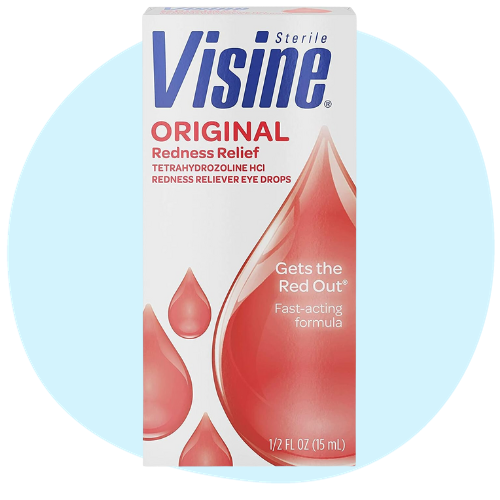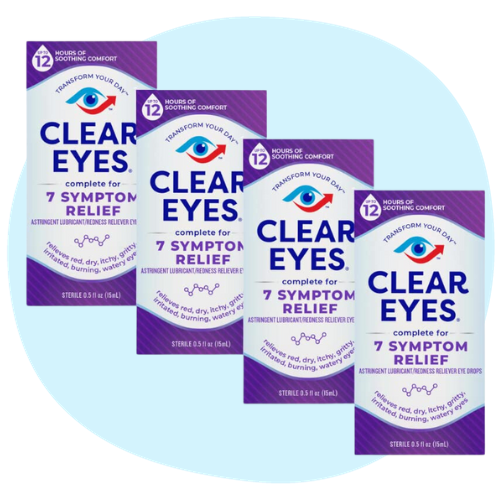Updated on October 9, 2024
Why Are My Eyes Red? Common Causes and Treatment


Vision Center is funded by our readers. We may earn commissions if you purchase something via one of our links.
Red eyes, also called bloodshot eyes, are usually due to swollen or dilated blood vessels on the eye's surface. Most people experience eye redness at some point. Typically, it’s nothing serious.
However, you should seek emergency medical care if eye redness occurs with intense pain and/or vision problems.
This article covers 10 common causes of eye redness and how they’re treated. If you’re concerned about a painful red eye, call your doctor right away.
When Should You Worry About Red Eyes?
Most cases of red eyes improve with home remedies. However, if the symptoms persist, you should call your doctor.
Seek medical help if your red eye is accompanied by more serious symptoms, such as:
- Severe eye pain
- Extreme light sensitivity
- Swelling in or around the eye
- Sudden vision changes
- Yellow or greenish discharge from one or both eyes
- A foreign object stuck in your eye
How to Get Rid of Red Eyes
There are various professional and home-based regimens for red eyes. Consult an eye doctor if the redness doesn’t go away with home treatment.
Professional Treatments
Professional treatments for red eyes include:
- Prescription eye drops. To treat specific conditions, such as dry eye or allergies
- Antimicrobial medications. Such as eye drops, oral tablets, or topical ointments to treat an eye infection
- Steroid medications. Such as tablets or eye drops to reduce inflammation
Best Eye Drops for Red Eyes
Although redness relief drops effectively clear your eyes, they don’t resolve the underlying condition.
Additionally, they should be used conservatively since they constrict the tiny blood vessels in your eye and aren’t ideal for your eye health if used regularly. It’s best to schedule an eye exam to receive proper treatment for your condition.
Other Home Remedies
Home treatments for red eyes include:
- Avoiding triggers such as irritants (smoke, dust, and pollen)
- Over-the-counter antihistamine eye drops to ease inflammation
- General hygiene, such as using clean towels and sleeping on clean bedding
- Cool compresses several times a day
- Lightly massaging your eyelids with clean hands and a clean, damp washcloth
- Avoiding eye makeup and contact lens wear until symptoms have gone
- Limiting screen time to prevent digital eye strain
- Gently washing your eyelids with an eyelid cleanser or cleansing wipes
How to Prevent Bloodshot Eyes
Here are some tips for preventing bloodshot eyes:
- Keep your hands clean and avoid touching your eyes with dirty hands
- Avoid going to bed with make-up
- Do not wear contact lenses longer than prescribed by your eye doctor
- Avoid eye-straining activities such as prolonged screen time
- Clean your contact lenses regularly
- Flush out your eyes with eye wash or water if you come into contact with contaminated substances
- Protect your eyes from sun exposure, dust, and other environmental irritants
10 Common Causes of Red Eyes
Many things can cause eye redness. Here are some of the most common causes and the additional symptoms that occur with each:
1. Dry Eye Syndrome
Dry eye syndrome is when the eyes are unable to produce adequate fluids (tears) to lubricate them.
Other symptoms of eye dryness include:
- Stinging or burning eye
- Excessive tearing
- Eye fatigue
- Discomfort when reading or watching
- Blurry vision
- A feeling of an object in the eye
- Difficulty with nighttime driving
- Sensitivity to light
2. Eye Injury
Trauma to the eye can cause redness due to bleeding or irritation. Something as simple as accidentally scratching your eye with a sharp fingernail can cause an eye injury.
Other symptoms include:
- Pain and swelling in the eye
- Bruising and redness
- Bleeding, accompanied by small red or black spots in the eye
- Changes in vision
- Changes in the appearance of the eyes
A penetrating injury (something sticking into the eye) is a medical emergency.
3. Eye Allergy
Allergies can cause symptoms like red and swollen eyes. Mold, pollen, and pet dander are common airborne allergens that can cause eye allergies. You can also react to cosmetics or eye drops containing ingredients you’re allergic to.
Other eye allergy symptoms include:
- Red and irritated eyes
- Itchiness in the eyes
- Swollen eyelids
- Soreness or a burning sensation in the eyes
- Sensitivity to light
- Excessive tearing
- Blurred vision
- Swollen eyelids
4. Pink Eye (Conjunctivitis)
Pink eye occurs when the clear membrane covering the white of your eye and the insides of your eyelids becomes red and inflamed.
Other symptoms of pink eye include:
- Itching
- A burning feeling
- Excessive tearing
- Eye discharge (mucus or pus)
- Feeling like there’s something in your eye
5. Subconjunctival Hemorrhage
A subconjunctival hemorrhage is the medical term for a broken blood vessel in the eye. When a blood vessel breaks, blood leaks onto the eye’s surface.
Though this red eye may look alarming, a popped blood vessel is typically not an emergency. Broken blood vessels usually go away independently in one to two weeks.
Call your doctor if a subconjunctival hemorrhage occurs with pain or decreased vision.
6. Corneal Ulcer
Corneal ulcers are sores on the cornea (clear dome at the front of the eye). They’re usually caused by a viral or bacterial infection.
Most corneal ulcers are extremely painful. Other symptoms include:
- Blurred vision
- Increased tearing
- Sensitivity to light
- Swollen eyelids
- Eye discharge
- Feeling like there’s something in your eye
7. Acute Angle-Closure Glaucoma
Glaucoma is a group of eye disorders that damage the optic nerve, which is necessary for good vision. It’s usually caused by very high eye pressure.
Acute angle-closure glaucoma causes a sudden increase in eye pressure. It’s a medical emergency that causes serious visual problems.
Symptoms include:
- Eye redness
- Severe headache
- Intense eye pain
- Nausea and vomiting
- Decreased or blurred vision
- Seeing rainbows or halos
8. Blepharitis
Blepharitis is eyelid inflammation. This common condition can make your eye and the skin along the edge of your eyelid appear red and swollen. It can be caused by a bacterial infection, clogged oil glands, or an eyelash mite infestation.
Additional symptoms may include:
- Crusty eyelids, especially in the morning
- Sensitivity to light
- A gritty feeling in your eye
- A burning sensation
- Itching
- Increased tearing
9. Uveitis
Uveitis is inflammation of the uvea, which is the middle part of the eye. The most common form of uveitis is called iritis, and it affects only the iris (colored part of the eye). Without prompt treatment, uveitis can lead to vision loss.
Symptoms of uveitis include:
- A red and painful eye
- Light sensitivity
- Eye floaters and flashes
- Blurred vision
10. Overuse of Contact Lenses
People who wear contact lenses frequently touch their eyes, so they’re at higher risk for many conditions that cause red eyes. These include:
- Eye infections
- Eye allergies
- Scratches on the cornea (corneal abrasions)
- Corneal ulcers
- Dry eyes
- Conjunctivitis
In addition to redness, contact lens overuse can cause pain, blurred vision, and light sensitivity. If you experience any of these symptoms, remove your contact lenses immediately. Call your doctor if the symptoms worsen or if they don’t go away on their own.
Other Causes of Red Eyes
Various other things can cause eye redness, including:
- Cigarette smoke
- Dust and other environmental irritants
- Eye strain
- Tiredness from not having enough sleep
- Chlorine from swimming pools
- Too much sun exposure
- Perfume
- Complications from eye surgery
Summary
Red or bloodshot eyes are common and typically not a cause for concern. They can be caused by many things, most of which will be resolved with home care.
However, red eyes with severe pain and/or vision problems can indicate a serious condition that needs emergency medical care. Without treatment, some causes of bloodshot eyes can lead to vision loss.
In this article
6 sources cited
Updated on October 9, 2024
Updated on October 9, 2024
About Our Contributors
Vincent Ayaga is a medical researcher and seasoned content writer with a bachelor's degree in Medical Microbiology. Specializing in disease investigation, prevention, and control, Vincent is dedicated to raising awareness about visual problems and the latest evidence-based solutions in ophthalmology. He strongly believes in the transformative power of ophthalmic education through research to inform and educate those seeking knowledge in eye health.
Dr. Melody Huang is an optometrist and freelance health writer with a passion for educating people about eye health. With her unique blend of clinical expertise and writing skills, Dr. Huang seeks to guide individuals towards healthier and happier lives. Her interests extend to Eastern medicine and integrative healthcare approaches. Outside of work, she enjoys exploring new skincare products, experimenting with food recipes, and spending time with her adopted cats.







